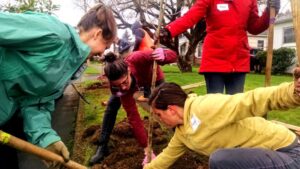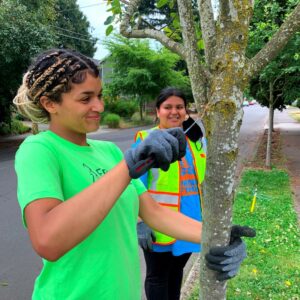Tag: tree survival
Show Your Trees Some Tree-LC
Caring for trees of all ages creates the diverse urban forest we need!
Sometimes trees need a little tree love + care. When we take care of our trees, we help them take care of us. This is the beautiful relationship between trees and community that is at the core of Friends of Trees. You can help foster and expand your community of tree stewards.
Because we are a tree-planting organization, we usually focus on young tree care. As our Community Tree Care Coordinator Andrew Land puts it, “we’re really in the business of pediatric arboriculture stewardship training.” That mouthful of words aside, we focus on young trees getting the care they need so that they can survive to be mature trees.
“We often talk about how important it is to have a diversity of tree species,” Andrew says. “It’s also really important that we have a diversity of tree ages. Trees planted at the same time will theoretically time out at the same time.”

While it’s important that we plant and develop our urban forest, it’s also important that we nurture and maintain. It’s not one or the other. It has to be both.
“When we talk about the public health benefits of trees, we’re really talking about mature trees,” Andrew says. “The benefits of a tree—like its ability to clean air and water—expands exponentially each year.”

This is why we don’t just plant trees and walk away. So what are some of the things you can do to take care of your trees? We encourage you to make a tree care plan for all your trees, no matter how old. The right attention over the years can maximize the life of your tree and the benefit it provides.
For the first few establishment years, proper watering and mulching are crucially important. After that, trees are relatively low maintenance, but you should still make sure to do regular inspection and maintenance pruning every few years. Maintaining a healthy mature tree provides so many benefits to you and your whole neighborhood.
“One of the best things you can do is simply notice,” Andrew says. “Notice how the trees at your own home are doing. Notice how your neighbors trees are doing. Talk to your neighbors about their trees.”
For example, if you see a particularly special mature tree, talk to the owner about nominating it for special status and protections, like the Portland Heritage Tree Program.
Together, we can’t plant so many trees in just a single Saturday morning. Tree care can be a lifelong mission. Check out some resources here.
Tree care – we do that too!

Congratulations, you helped plant 50,000 trees and native shrubs last season! Now what? Good thing Friends of Trees isn’t just a tree planting organization–tree care is also on the list because we want the trees we plant to survive and grow and thrive.
It works.The survival rate for urban trees planted the Friends of Trees way, together, with guided post-planting care from our Tree Team, is 97% (based on Portland street trees planted last season). For the subset of trees we’ve been monitoring for nine years since planting it’s an 88% survival rate.
Our trees planted in natural areas also have strong survival rates, especially given some very challenging conditions; for example, some planting sites are not accessible for watering; some plants get eaten by wildlife; humans sometimes trample or vandalize; etc. Some studies indicate that an acceptable minimum survival rate for riparian area restoration plantings is 50%, so our survival rates of 81% in year one and 70% after three years are particularly impressive.
How do we help trees thrive?
We water. We prune. We mulch. We visit and assess. We do this for the street and yard trees planted through our Neighborhood Trees program as well as for the native trees and shrubs planted in our Green Space program.
As part of our Neighborhood Trees post-planting care, we:
- continually share information with tree-recipients about how much water, mulch and pruning trees need;
- deliver and apply free mulch soon after trees are planted;
- offer a summer watering service for a reasonable fee;
- have a Summer Inspector program where trained volunteers visit all newly planted trees twice in the first summer after planting to inspect for tree health, leaving tree care info for the tree recipient.
- have a longer term monitoring program where we visit subsets of trees planted anywhere from two to 10 years ago, to track health and growth;
- prune trees throughout the year (except for a few weeks in the spring and fall when trees are budding or dropping leaves). We rotate neighborhoods each year and focus most of our work on low income, low canopy and/or historically under-served communities.
Did we mention we prune? Last season we pruned more than 1,600 street trees, which is vital toward proper growth and really helps them survive wind, snow, and ice storms.
Our Green Space program also cares for the new trees and shrubs planted in natural areas, and we do this for up to 10 years after planting. The team is often joined by employee volunteer groups who help with summer maintenance tasks such as watering, mulching, and weeding (also called “day-lighting” since we’re clearing space around new plantings to provide for more light and air, and to reduce competition with weeds). We also assess for survival and replant when necessary.
Volunteers help with this! We train volunteers to inspect and prune trees, and volunteers are crucial to effectively mulching thousands of new trees at tree care events.
All told, we care for and monitor more than 54,000 trees a year!
We’re spreading the good word about trees.
We spend much of the summer spreading the word. Our Volunteer & Outreach Team, aided by dedicated Tree Team Ambassadors, attend events, festivals and fairs; plus, we have a crew of Canvassers who go door to door in priority neighborhoods. We strive to reach historically under-served, low-canopy neighborhoods with information about how to volunteer with us and how to get a tree from us. Interested in being a part of this? We’d love for you to join us.

